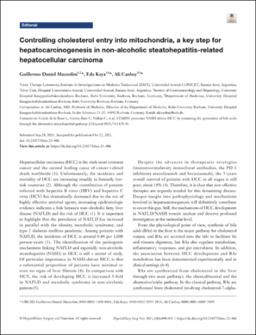| dc.description.abstract | Hepatocellular carcinoma (HCC) is the sixth most common cancer and the second leading cause of cancer-related death worldwide (1). Unfortunately, the incidence and mortality of HCC are increasing steadily in formerly low-risk countries (2). Although the contribution of patients infected with hepatitis B virus (HBV) and hepatitis C virus (HCV) has dramatically decreased due to the use of highly effective antiviral agents, increasing epidemiologic evidence indicates a link between non-alcoholic fatty liver disease (NAFLD) and the risk of HCC (1). It is important to highlight that the prevalence of NAFLD has increased in parallel with the obesity, metabolic syndrome, and type 2 diabetes mellitus pandemic. Among patients with NAFLD, the incidence of HCC is around 0.44 per 1,000 person-years (3). The identification of the pathogenic mechanisms linking NAFLD and especially non-alcoholic steatohepatitis (NASH) to HCC is still a matter of study. Of particular importance in NASH-driven HCC is that a substantial proportion of patients have minimal or even no signs of liver fibrosis (4). In comparison with HCV, the risk of developing HCC is increased 5-fold in NAFLD and metabolic syndrome in non-cirrhotic patients (5).
Despite the advances in therapeutic strategies (immunostimulatory monoclonal antibodies, the PD-1 inhibitors atezolizumab and bevacizumab), the 5-years overall survival of patients with HCC in all stages is still poor, about 18% (1). Therefore, it is clear that new effective therapies are urgently needed for this devastating disease. Deeper insight into pathophysiology and mechanisms involved in hepatocarcinogenesis will definitively contribute to cover this gap. Still, the mechanisms of HCC development in NAFLD/NASH remain unclear and deserve profound investigation at the molecular level.
From the physiological point of view, synthesis of bile acids (BAs) in the liver is the major pathway for cholesterol output, and BAs are secreted into the bile to facilitate fat and vitamin digestion, but BAs also regulate metabolism, inflammatory responses, and gut microbiota. In addition, the association between HCC development and BAs metabolism has been demonstrated experimentally and in clinical settings (6-8). | es |


